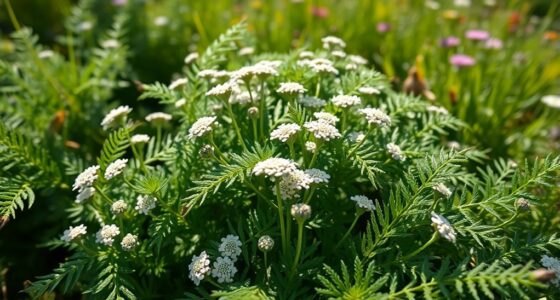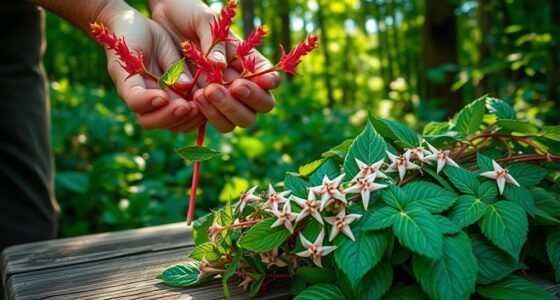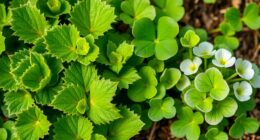Sustainability concerns with popular medicinals arise from overharvesting wild plants, which threatens biodiversity and ecosystems. Large-scale farming and habitat disruption further deplete natural sources and reduce genetic diversity. Also, production processes can harm the environment through soil degradation and high energy use. Supporting responsible harvesting, sustainable cultivation practices, and eco-friendly manufacturing helps protect these essential plants. Continue exploring to understand how you can make more sustainable choices with your medicinal use.
Key Takeaways
- Overharvesting wild medicinal plants threatens biodiversity and risks species extinction, disrupting ecosystems and local communities.
- Large-scale cultivation practices can cause habitat fragmentation, reduce genetic diversity, and impair ecosystem resilience.
- Environmental impacts from medicinal plant farming include soil degradation, water depletion, and increased greenhouse gas emissions.
- Unsustainable harvesting and habitat loss diminish plant population resilience and threaten endangered species.
- Supply chain transparency and responsible sourcing are essential to prevent ecosystem harm and ensure ethical, sustainable practices.
Overharvesting of Wild Plants and Its Impact
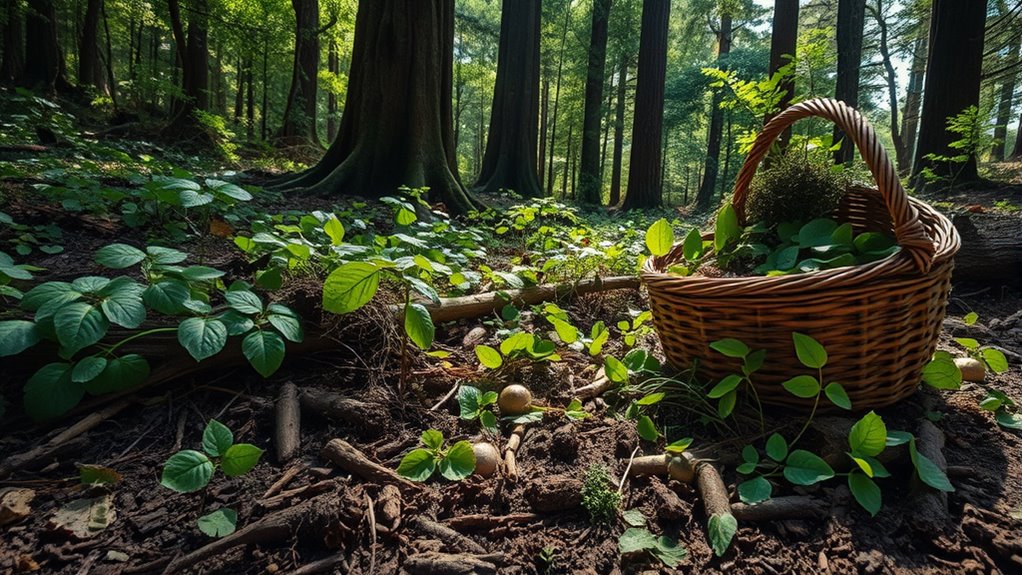
Overharvesting of wild plants has become a significant threat to biodiversity and the sustainability of medicinal resources. When you rely on wild harvesting, you risk depleting crucial populations before they can regenerate. This practice disrupts the natural supply chain, making it difficult to ensure consistent availability of key medicinal plants. Unsustainable harvesting can lead to the extinction of species, which in turn affects ecosystems and the communities that depend on them. As demand for herbal remedies grows, the pressure on wild populations intensifies, often resulting in overexploitation. This short-sighted approach jeopardizes both biodiversity and future medicinal supply, emphasizing the need for sustainable practices. Protecting wild plants is essential to maintaining a balanced, resilient supply chain of medicinal resources. Implementing conservation measures can help mitigate these impacts and promote sustainable harvesting methods.
The Role of Cultivation in Sustainable Sourcing
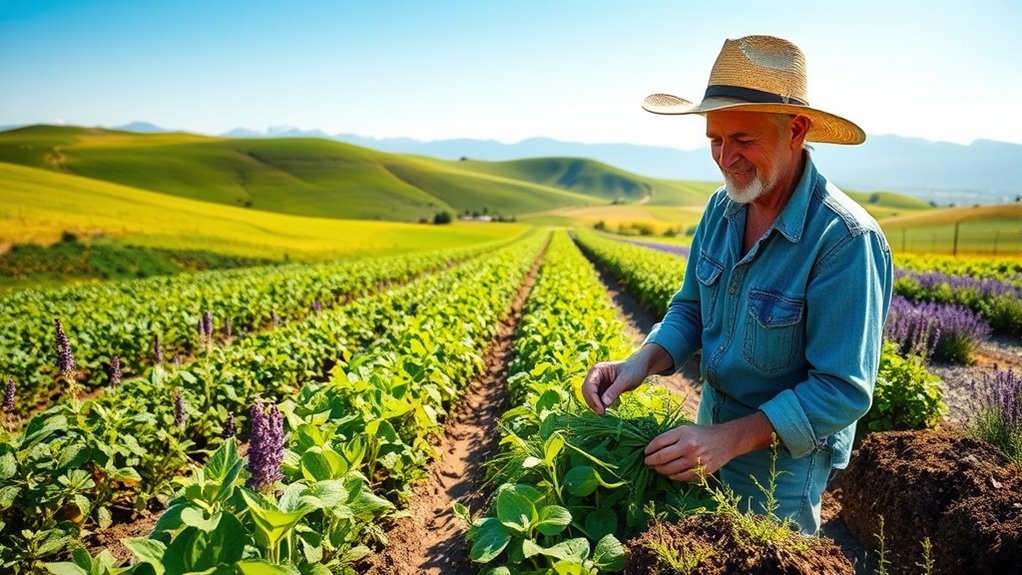
By cultivating medicinal plants responsibly, you help guarantee sustainable sourcing and protect wild populations. Implementing responsible farming practices and supporting biodiversity preservation can make a real difference. Plus, local cultivation offers economic and environmental benefits to communities. Additionally, adopting organic farming practices can enhance the quality of medicinal plants while reducing environmental impact.
Responsible Farming Practices
Responsible farming practices are essential for ensuring the sustainability of medicinal plant sourcing. You should prioritize farms with organic certification, which guarantees the use of natural methods and avoids synthetic chemicals. This reduces chemical runoff and soil degradation, helping preserve ecosystems. Limiting pesticide use is also vital; excessive application harms beneficial insects, pollutes water sources, and weakens plant health over time. Instead, adopt integrated pest management strategies that minimize chemical reliance while protecting crops. By supporting farmers committed to organic standards and reduced pesticide use, you contribute to healthier environments and more sustainable harvesting. These practices not only safeguard biodiversity but also guarantee that medicinal plants remain available for future generations, aligning health benefits with environmental responsibility. Additionally, promoting sustainable cultivation methods ensures that the demand for medicinal herbs does not lead to overharvesting or habitat destruction, securing natural resources for the future.
Biodiversity Preservation Efforts
Cultivation plays an essential role in preserving biodiversity by reducing pressure on wild populations of medicinal plants. When you cultivate plants sustainably, you help guarantee their medicinal efficacy remains consistent without overharvesting wild sources. This practice supports the conservation of natural habitats and prevents the decline of rare or endangered species. By incorporating traditional knowledge into cultivation methods, you honor indigenous practices that have long promoted sustainable harvesting techniques. Cultivated medicinal plants can meet market demand while safeguarding wild populations, therefore maintaining ecological balance. Additionally, cultivation efforts foster genetic diversity, which is fundamental for resilience against pests and climate change. Wrths are increasingly emphasizing the importance of sustainable practices in herbal medicine to ensure long-term ecological health. Overall, these efforts contribute to a more sustainable medicinal industry, aligning your use of medicinal plants with environmental preservation and respect for traditional wisdom.
Local Cultivation Benefits
Local cultivation plays a crucial role in promoting sustainable sourcing of medicinal plants. By supporting local farming, you help reduce the environmental impact of transportation and lower carbon emissions. Cultivating medicinal plants locally also encourages the preservation of plant diversity, as diverse local ecosystems are more resilient and better able to sustain various species. When you choose locally grown medicinal herbs, you’re fostering a closer connection between producers and consumers, which can lead to more ethical and environmentally conscious practices. Additionally, local cultivation often employs traditional farming methods that are gentler on the land, promoting soil health and reducing reliance on chemical inputs. Overall, supporting local farming helps maintain healthy ecosystems and ensures a more sustainable supply of medicinal plants for the future.
Environmental Consequences of Large-Scale Farming
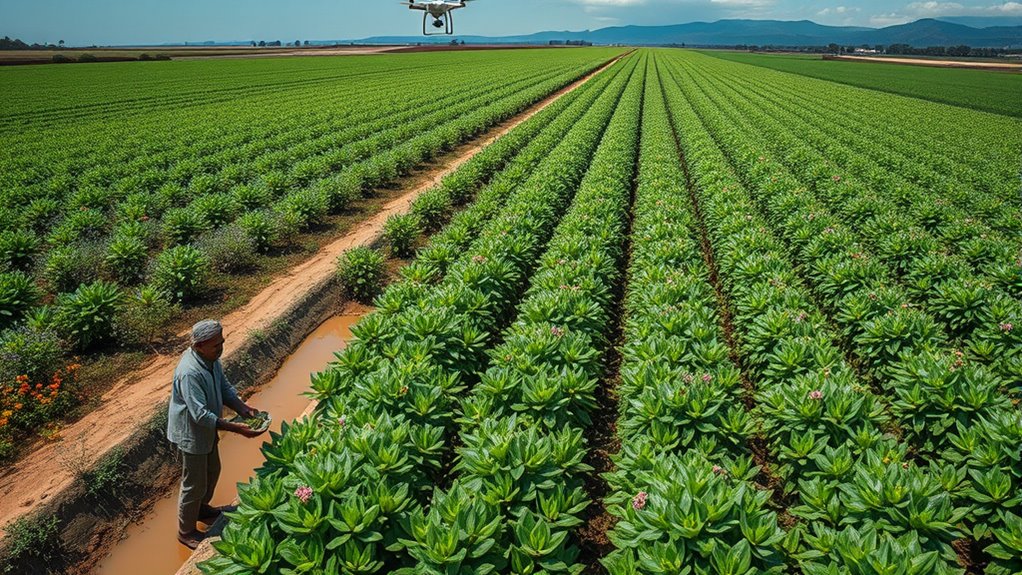
Large-scale farming can harm the environment by causing soil degradation and reducing land fertility. It also consumes大量的水资源, which can deplete local supplies, and threatens biodiversity by replacing native habitats. These issues highlight the need to think about sustainable practices in medicinal cultivation. Implementing best farming practices can help mitigate these environmental impacts and promote ecological balance.
Soil Degradation Risks
When farming practices rely heavily on intensive methods, soil degradation quickly becomes a significant environmental concern. You may notice that over time, soil fertility drops as nutrients are depleted faster than they can be replenished. This reduces crop yields and impacts the quality of medicinal plants you harvest. Without proper erosion control, wind and water wash away the topsoil, further exposing less fertile layers beneath. Continuous monoculture and excessive use of chemical fertilizers accelerate this process, making the land less productive and more vulnerable to erosion. Protecting soil health is essential; implementing crop rotation, organic amendments, and erosion barriers helps maintain soil fertility. Additionally, choosing appropriate payment processing methods can support sustainable business practices by reducing paper waste and streamlining transactions. Neglecting these practices risks long-term soil degradation, threatening both the environment and the sustainable production of medicinal plants.
Water Usage Concerns
Have you ever considered how intensive farming methods can drain water resources at an unsustainable rate? Large-scale cultivation of medicinal plants often relies on excessive water use, risking local water supplies. To address this, improving water conservation and irrigation efficiency becomes essential. You can help by supporting farms that implement drip irrigation or rainwater harvesting. Be aware that:
- Over-irrigation wastes valuable water resources
- Monoculture farming increases water demand
- Unsustainable practices reduce groundwater levels
- Poor irrigation leads to soil erosion and salinity
- Responsible water use can minimize environmental impact
- Utilizing efficient irrigation technologies can significantly reduce water consumption and support sustainable farming practices
Biodiversity Loss
Intensive farming of medicinal plants can considerably disrupt local ecosystems by reducing biodiversity. When large areas are dedicated to monocultures, you risk shrinking genetic diversity among plant populations, making them more vulnerable to pests and diseases. Habitat fragmentation occurs as natural landscapes are cleared to expand cultivation, isolating species and disrupting ecological networks. This loss of habitat can threaten not only the targeted medicinal plants but also the many organisms that depend on those ecosystems. As a result, entire communities of plants and animals decline, weakening ecosystem resilience. You should be aware that such practices threaten the health of surrounding environments, leading to decreased biodiversity and compromised ecological stability. Protecting genetic diversity and minimizing habitat fragmentation are essential steps toward sustainable medicinal plant farming. Additionally, implementing a variety of cultivation methods can help preserve ecosystem balance and promote biodiversity.
Supply Chain Challenges and Transparency

Supply chain challenges and transparency are critical issues impacting the sustainability of medicinal production. Without clear supply chain transparency, it’s difficult to verify if ingredients are ethically sourced or sustainably harvested. You might unknowingly support practices that harm ecosystems or exploit workers. To address these issues, focus on:
Supply chain transparency ensures ethical sourcing and sustainable medicinal production practices.
- Ensuring suppliers follow ethical sourcing standards
- Tracking raw materials from origin to end product
- Promoting fair labor practices
- Reducing illegal or unsustainable harvesting
- Building trust through transparent reporting
- Utilizing unique and wicked planters to support sustainable and eco-friendly gardening practices.
The Carbon Footprint of Medicinal Production
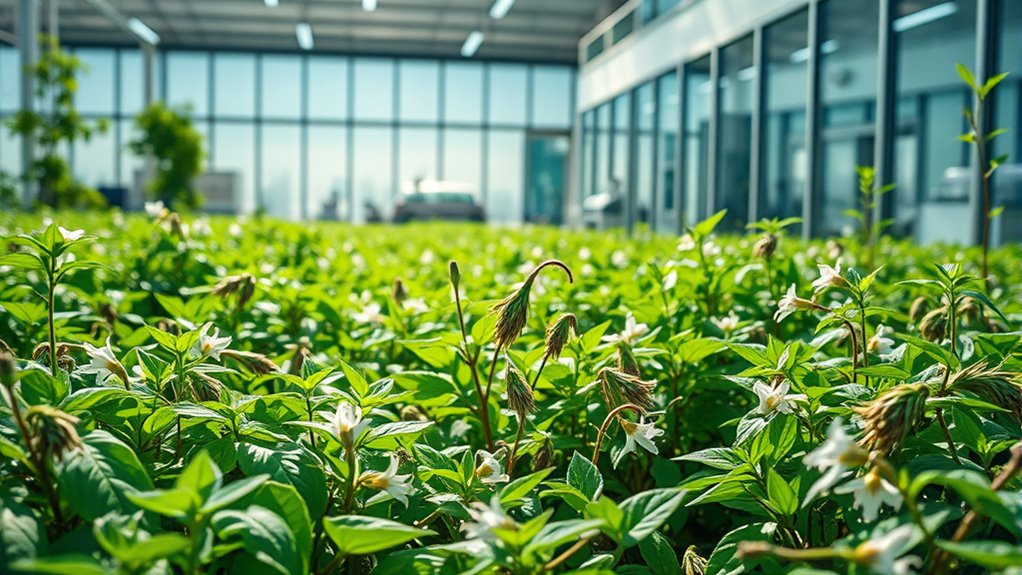
Understanding the carbon footprint of medicinal production is essential for evaluating its environmental impact. You should recognize that manufacturing processes contribute markedly to carbon emissions and energy consumption. From raw material extraction to processing and packaging, each step requires energy, often derived from fossil fuels, which releases greenhouse gases. The more energy-intensive the production, the higher the carbon emissions. Advanced technologies can reduce energy use, but many facilities still rely on outdated methods. By assessing these factors, you can better understand how medicinal manufacturing affects climate change. Minimizing energy consumption and adopting cleaner energy sources are vital strategies to lower the overall carbon footprint. Moreover, implementing sustainable manufacturing practices can significantly lessen environmental impacts. Ultimately, addressing these issues helps make the production of medicines more sustainable and environmentally responsible.
Biodiversity Loss and Ecosystem Disruption
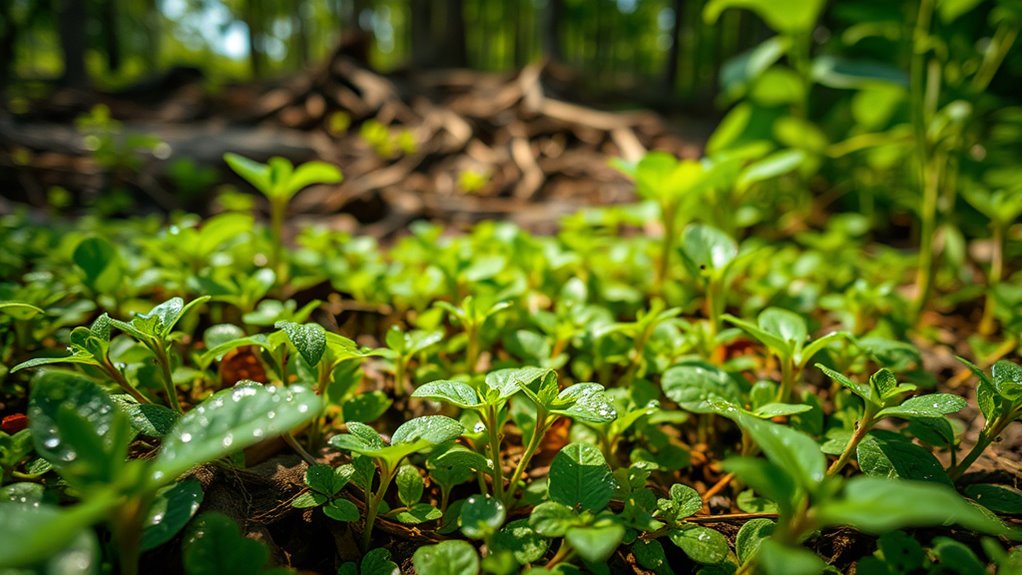
The harvesting and production of medicinal plants can substantially threaten local biodiversity and disrupt ecosystems. When you overharvest, you reduce genetic diversity, making plant populations more vulnerable to disease and environmental changes. Habitat fragmentation occurs as forests and wild areas are divided, isolating plant populations and impairing their ability to reproduce. This process weakens ecosystems, impacting not just plants but entire communities that depend on them. You should consider:
- Loss of rare and endemic species
- Decreased resilience of ecosystems
- Disruption of pollination and seed dispersal
- Increased risk of invasive species takeover
- Long-term decline in ecosystem services
Ethical Considerations in Wild Harvesting Practices
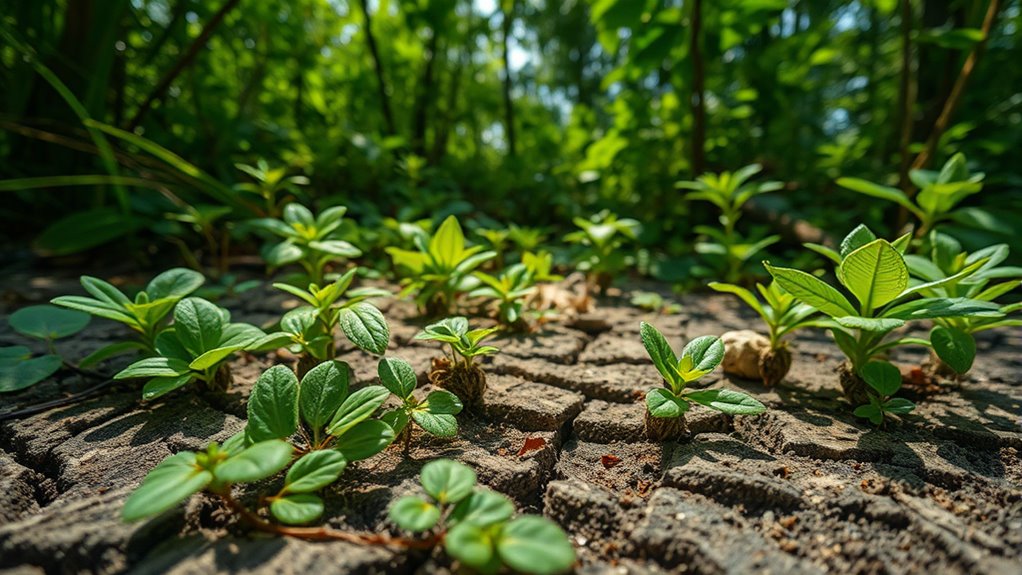
Wild harvesting of medicinal plants raises important ethical questions about our responsibility to protect natural resources. Ethical harvesting involves collecting wild plants in a way that minimizes harm, preserves plant populations, and respects ecosystems. Wild plant ethics emphasize sustainable practices, ensuring that harvesting doesn’t threaten species or disrupt habitats. As a consumer or practitioner, you should consider whether harvesting methods support conservation goals and whether wild plants are sourced responsibly. Overharvesting or improper collection can lead to population declines and loss of biodiversity. By prioritizing ethical harvesting, you help maintain the balance between traditional medicinal use and ecological sustainability. Practicing wild plant ethics means advocating for policies that protect plant populations and educating others about sustainable collection practices, ensuring medicinal resources remain available for future generations.
Innovations in Sustainable Harvesting Methods
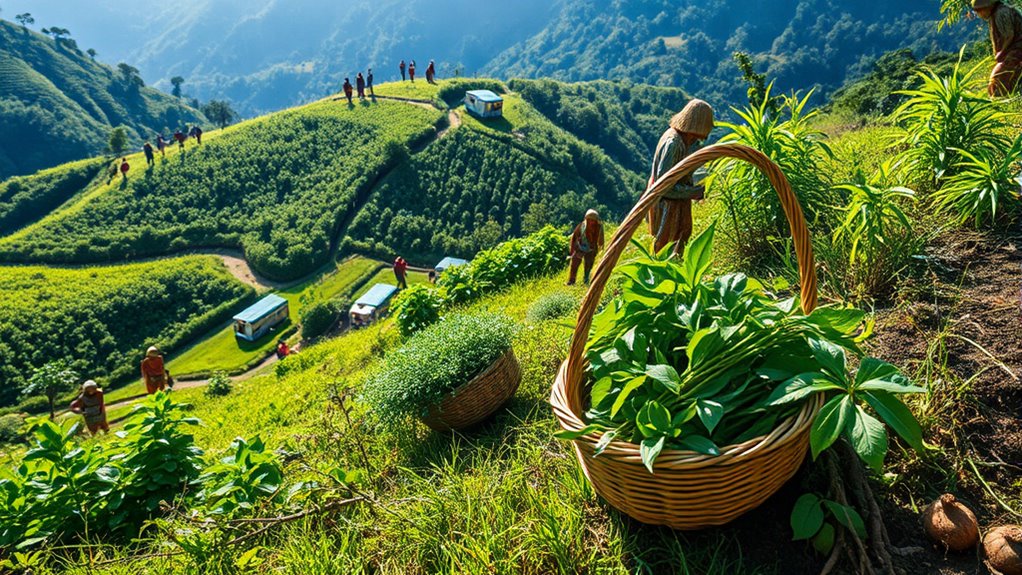
Innovations in sustainable harvesting methods are transforming how practitioners and consumers gather medicinal plants, making the process more eco-friendly and efficient. New techniques focus on sustainable extraction and eco friendly collection, reducing environmental impact while maintaining plant health. These innovations include controlled harvesting, cultivation, and the use of biodegradable tools. By adopting these methods, you help preserve wild populations and promote biodiversity. Key approaches involve:
- Selective harvesting to minimize plant damage
- Cultivating medicinal plants to reduce wild collection
- Using biodegradable tools to lessen waste
- Implementing rotational harvesting to prevent overharvesting
- Training harvesters in eco friendly collection techniques
These innovations ensure medicinal plant sourcing remains sustainable, supporting ecosystems and future availability. Your participation in adopting these methods helps balance medicinal needs with ecological preservation.
Consumer Choices and Supporting Responsible Practices

Your consumer choices directly influence the sustainability of medicinal plant sourcing. By choosing reputable sources, you help combat herbal adulteration, which can harm both the environment and consumer health. Supporting certified products ensures plants are harvested responsibly and ethically. Increasing consumer awareness about the origins of medicinal herbs encourages manufacturers to adopt sustainable practices. It’s essential to research brands and inquire about their sourcing methods. Avoid products linked to illegal harvesting or harmful extraction techniques. Your awareness can push the industry toward greater transparency and accountability. When you prioritize responsible practices, you contribute to conserving wild populations and promoting fair trade. Small decisions, like selecting sustainable brands, have a powerful impact on the future of medicinal plant conservation and quality.
Frequently Asked Questions
How Do Regulations Influence Sustainable Harvesting Practices Globally?
Regulations shape how you approach sustainable harvesting practices worldwide by enforcing strict compliance standards. They require you to follow specific harvesting protocols, which help protect plant populations and ecosystems. When you adhere to these rules, you guarantee that your collection methods are environmentally responsible and legally sound. Regulatory compliance also encourages ongoing monitoring and adaptation, making sure that medicinal plant resources remain available for future generations.
Are There Certifications Indicating Environmentally Friendly Medicinal Products?
You’ll find that eco-labeling and organic certification gently guide you toward environmentally friendly medicinal products. These certifications, like organic certification, serve as a subtle nod to sustainable practices, ensuring you choose products that respect nature. They help you enjoy the benefits of natural remedies while supporting responsible harvesting and production. With these labels, you can confidently embrace medicinal options that prioritize the planet’s health without sacrificing efficacy.
What Are the Economic Impacts on Local Communities Involved in Wild Harvesting?
You might not realize it, but wild harvesting creates economic dependency for local communities, providing essential income sources. This reliance can boost community resilience, helping them withstand economic shifts. However, overharvesting risks depleting resources, threatening long-term sustainability. Balancing economic benefits with conservation efforts is critical, ensuring communities can thrive without compromising the environment. Supporting sustainable harvesting practices helps protect their livelihoods and preserves natural resources for future generations.
How Do Climate Change Effects Alter Medicinal Plant Availability?
Climate change affects medicinal plant availability by causing climate migration, which shifts where plants grow, and soil degradation, reducing plant health. You might notice fewer local medicinal plants or they become harder to harvest. These changes force you to travel further or rely on less effective alternatives. As ecosystems shift, your access to essential medicinal resources diminishes, impacting traditional practices and potentially threatening your health and community resilience.
Can Synthetic Alternatives Reduce Pressure on Wild Plant Populations?
You can explore synthetic replacements to reduce pressure on wild medicinal plants. Advances in cultivation techniques allow for large-scale, sustainable farming, decreasing the need to harvest from wild populations. Synthetic alternatives, like lab-grown compounds, offer effective options without harming ecosystems. By adopting these methods, you help preserve biodiversity and guarantee medicinal plant availability for future generations, addressing sustainability concerns while maintaining access to essential treatments.
Conclusion
By choosing sustainably sourced medicinals, you can help protect wild plants and ecosystems. Did you know that over 80% of medicinal plants are wild-harvested, risking biodiversity loss? Your informed choices support responsible practices, reduce environmental impact, and promote ethical harvesting. Together, we can guarantee these valuable resources remain available for future generations. Every purchase you make has the power to make a positive difference—so choose wisely and support sustainability in medicinal sourcing.




